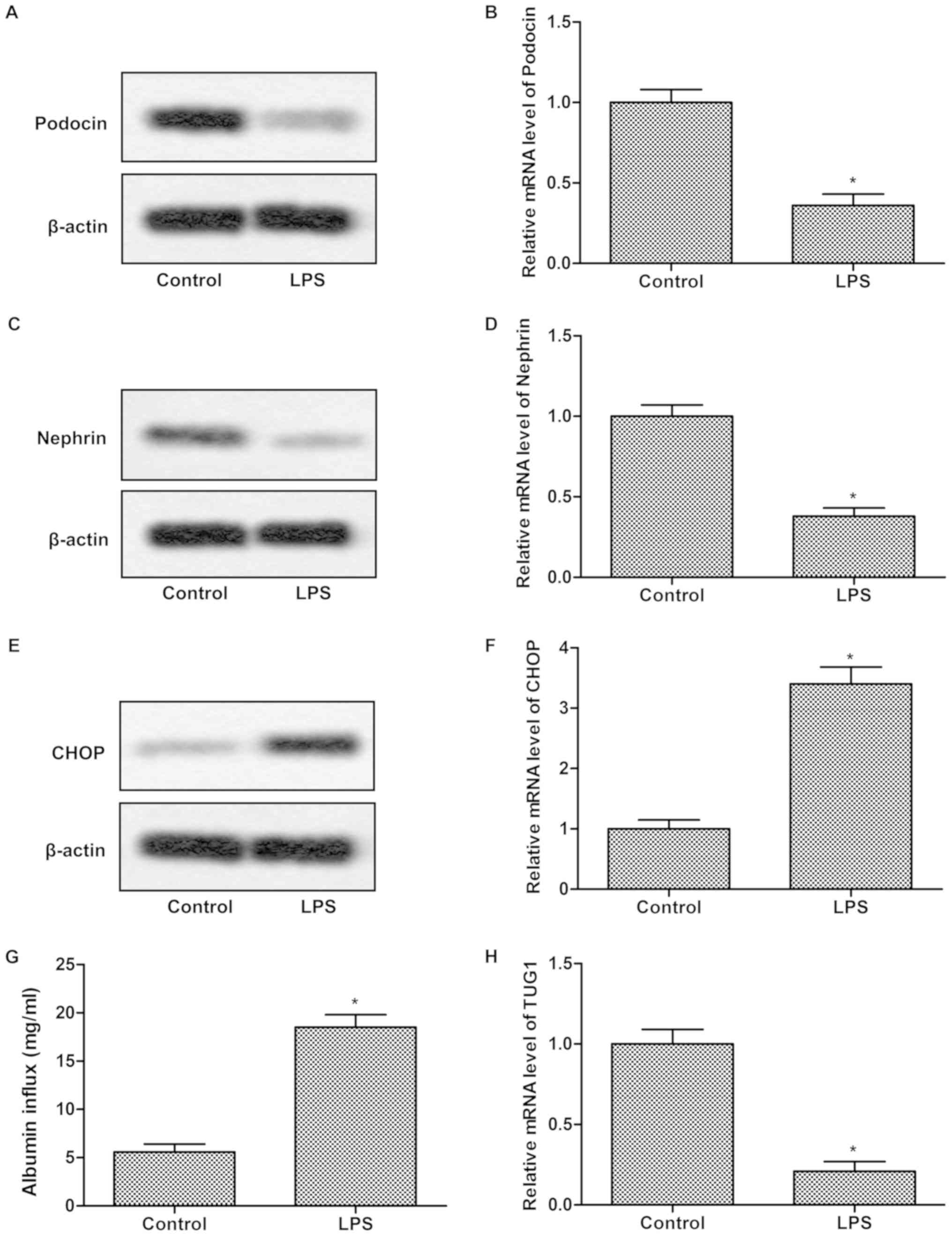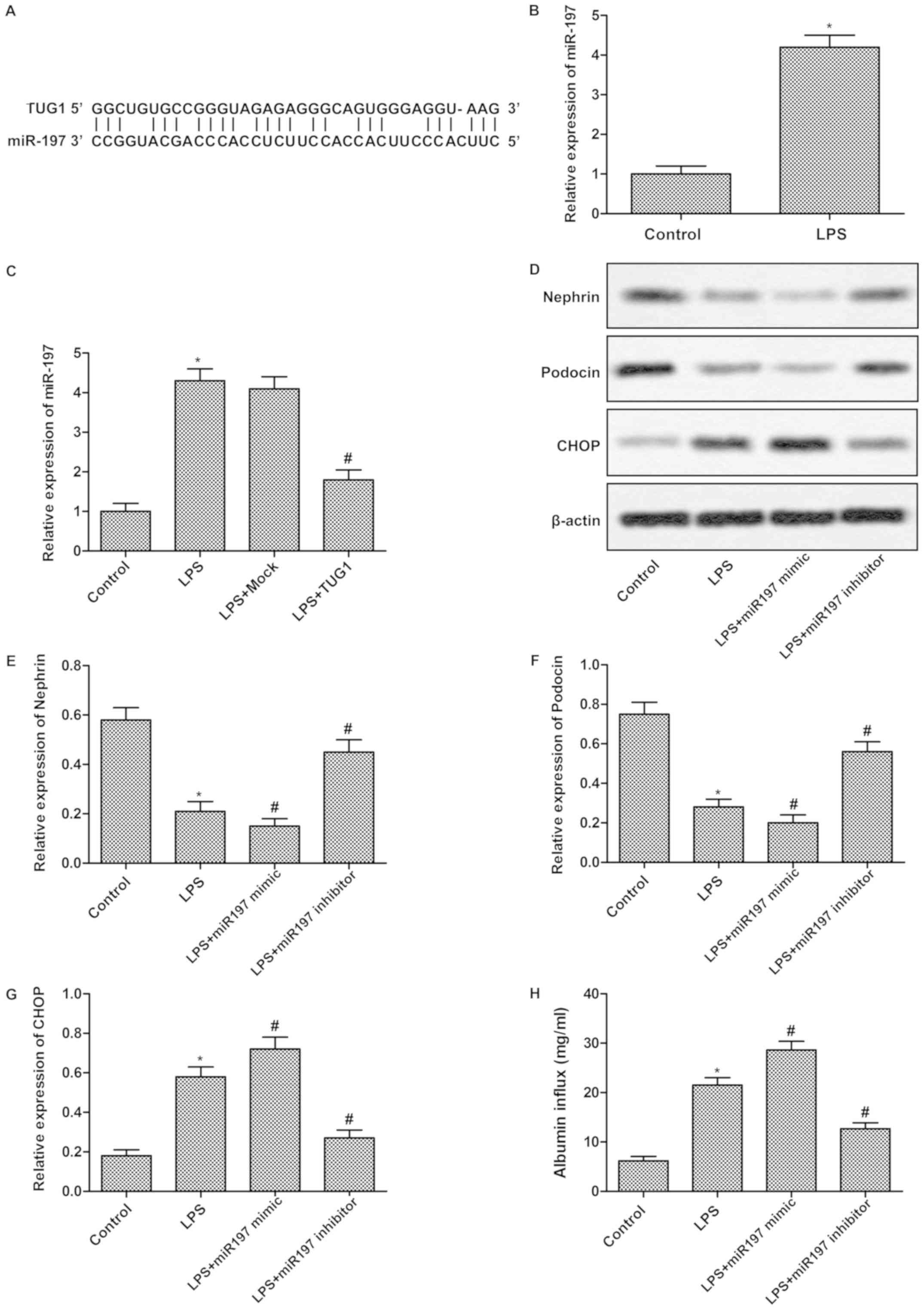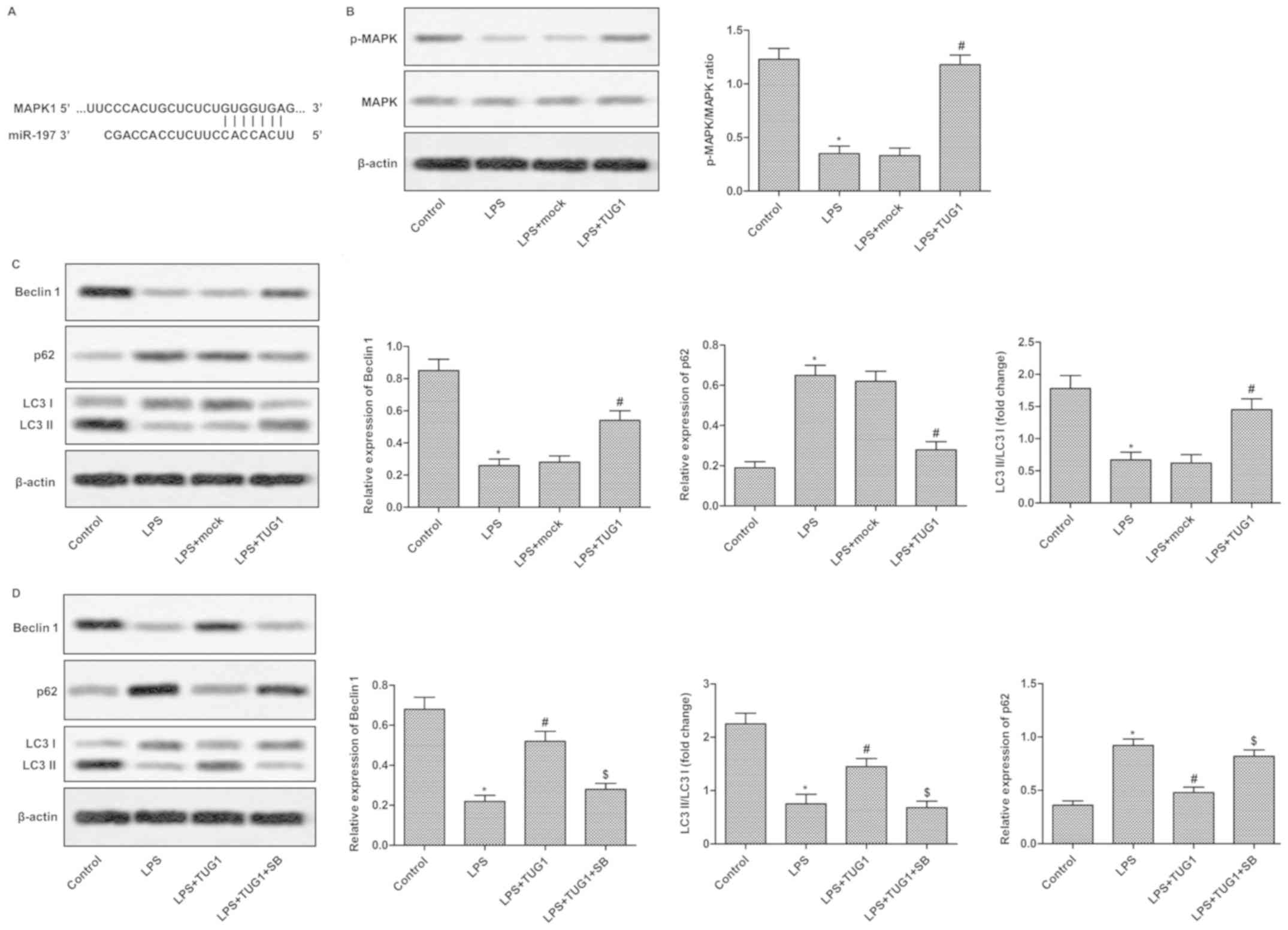|
1
|
Kriz W, Gretz N and Lemley KV: Progression
of glomerular diseases: Is the podocyte the culprit? Kidney Int.
54:687–697. 1998. View Article : Google Scholar : PubMed/NCBI
|
|
2
|
Ijpelaar DH, Schulz A, Koop K, Schlesener
M, Bruijn JA, Kerjaschki D, Kreutz R and de Heer E: Glomerular
hypertrophy precedes albuminuria and segmental loss of podoplanin
in podocytes in Munich-Wistar-Fromter rats. Am J Physiol Renal
Physiol. 294:F758–F767. 2008. View Article : Google Scholar : PubMed/NCBI
|
|
3
|
Djebali S, Davis CA, Merkel A, Dobin A,
Lassmann T, Mortazavi A, Tanzer A, Lagarde J, Lin W, Schlesinger F,
et al: Landscape of transcription in human cells. Nature.
489:101–108. 2012. View Article : Google Scholar : PubMed/NCBI
|
|
4
|
Ponting CP, Oliver PL and Reik W:
Evolution and functions of long noncoding RNAs. Cell. 136:629–641.
2009. View Article : Google Scholar : PubMed/NCBI
|
|
5
|
Young TL, Matsuda T and Cepko CL: The
noncoding RNA taurine upregulated gene 1 is required for
differentiation of the murine retina. Curr Biol. 15:501–512. 2005.
View Article : Google Scholar : PubMed/NCBI
|
|
6
|
Li SY and Susztak K: The long noncoding
RNA Tug1 connects metabolic changes with kidney disease in
podocytes. J Clin Invest. 126:4072–4075. 2016. View Article : Google Scholar : PubMed/NCBI
|
|
7
|
Yu C, Li L, Xie F, Guo S, Liu F, Dong N
and Wang Y: lncRNA TUG1 sponges miR-204-5p to promote osteoblast
differentiation through upregulating Runx2 in aortic valve
calcification. Cardiovasc Res. 114:168–179. 2018. View Article : Google Scholar : PubMed/NCBI
|
|
8
|
Cao J, Han X, Qi X, Jin X and Li X: TUG1
promotes osteosarcoma tumorigenesis by upregulating EZH2 expression
via miR-144-3p. Int J Oncol. 51:1115–1123. 2017. View Article : Google Scholar : PubMed/NCBI
|
|
9
|
Zhao L, Sun H, Kong H, Chen Z, Chen B and
Zhou M: The Lncrna-TUG1/EZH2 axis promotes pancreatic cancer cell
proliferation, migration and EMT phenotype formation through
sponging Mir-382. Cell Physiol Biochem. 42:2145–2158. 2017.
View Article : Google Scholar : PubMed/NCBI
|
|
10
|
Lv W, Fan F, Wang Y, Gonzalez-Fernandez E,
Wang C, Yang L, Booz GW and Roman RJ: Therapeutic potential of
microRNAs for the treatment of renal fibrosis and CKD. Physiol
Genomics. 50:20–34. 2018. View Article : Google Scholar : PubMed/NCBI
|
|
11
|
Park EJ, Jung HJ, Choi HJ, Cho JI, Park HJ
and Kwon TH: miR-34c-5p and CaMKII are involved in
aldosterone-induced fibrosis in kidney collecting duct cells. Am J
Physiol Renal Physiol. 314:F329–F342. 2018. View Article : Google Scholar : PubMed/NCBI
|
|
12
|
Xie Y, Jia Y, Cuihua X, Hu F, Xue M and
Xue Y: Urinary exosomal MicroRNA profiling in incipient type 2
diabetic kidney disease. J Diabetes Res. 2017:69789842017.
View Article : Google Scholar : PubMed/NCBI
|
|
13
|
Wang X, Lin B, Nie L and Li P:
microRNA-20b contributes to high glucose-induced podocyte apoptosis
by targeting SIRT7. Mol Med Rep. 16:5667–5674. 2017. View Article : Google Scholar : PubMed/NCBI
|
|
14
|
Xie H, Li J, Gao H, Wang J, Li C, Xu Y and
Liu C: Total flavone of desmodium styracifolium relieved apoptosis
and autophagy of COM-induced HK-2 cells by regulating KIM-1 via
p38/MAPK pathway. Mol Cell Biochem. 442:169–175. 2018. View Article : Google Scholar : PubMed/NCBI
|
|
15
|
Tan X, Chen Y, Liang X, Yu C, Lai Y, Zhang
L, Zhao X, Zhang H, Lin T, Li R and Shi W:
Lipopolysaccharide-induced podocyte injury is mediated by
suppression of autophagy. Mol Med Rep. 14:811–818. 2016. View Article : Google Scholar : PubMed/NCBI
|
|
16
|
Livak KJ and Schmittgen TD: Analysis of
relative gene expression data using real-time quantitative PCR and
the 2(-Delta Delta C(T)) method. Methods. 25:402–408. 2001.
View Article : Google Scholar : PubMed/NCBI
|
|
17
|
Guo B, Lyu Q, Slivano OJ, Dirkx R,
Christie CK, Czyzyk J, Hezel AF, Gharavi AG, Small EM and Miano JM:
Serum response factor is essential for maintenance of podocyte
structure and function. J Am Soc Nephrol. 29:416–422. 2018.
View Article : Google Scholar : PubMed/NCBI
|
|
18
|
Guan Y, Nakano D, Zhang Y, Li L, Liu W,
Nishida M, Kuwabara T, Morishita A, Hitomi H, Mori K, et al: A
protease-activated receptor-1 antagonist protects against podocyte
injury in a mouse model of nephropathy. J Pharmacol Sci. (pii):
S1347 8613. 30128–30137. 2017.
|
|
19
|
Feng M, Tang PM, Huang XR, Sun SF, You YK,
Xiao J, Lv LL, Xu AP and Lan HY: TGF-β mediates renal fibrosis via
the Smad3-Erbb4-IR long noncoding RNA axis. Mol Ther. 26:148–161.
2018. View Article : Google Scholar : PubMed/NCBI
|
|
20
|
Huang HW, Xie H, Ma X, Zhao F and Gao Y:
Upregulation of lncRNA PANDAR predicts poor prognosis and promotes
cell proliferation in cervical cancer. Eur Rev Med Pharmacol Sci.
21:4529–4535. 2017.PubMed/NCBI
|
|
21
|
Long J, Badal SS, Ye Z, Wang Y, Ayanga BA,
Galvan DL, Green NH, Chang BH, Overbeek PA and Danesh FR: Long
noncoding RNA Tug1 regulates mitochondrial bioenergetics in
diabetic nephropathy. J Clin Invest. 126:4205–4218. 2016.
View Article : Google Scholar : PubMed/NCBI
|
|
22
|
Tana C, Giamberardino MA and Cipollone F:
microRNA profiling in atherosclerosis, diabetes, and migraine. Ann
Med. 49:93–105. 2017. View Article : Google Scholar : PubMed/NCBI
|
|
23
|
Chen J, Gu Y and Shen W: MicroRNA-21
functions as an oncogene and promotes cell proliferation and
invasion via TIMP3 in renal cancer. Eur Rev Med Pharmacol Sci.
21:4566–4576. 2017.PubMed/NCBI
|
|
24
|
Fulda S, Gorman AM, Hori O and Samali A:
Cellular stress responses: Cell survival and cell death. Int J Cell
Biol. 2010:2140742010. View Article : Google Scholar : PubMed/NCBI
|
|
25
|
Wei WY, Ma ZG, Zhang N, Xu SC, Yuan YP,
Zeng XF and Tang QZ: Overexpression of CTRP3 protects against
sepsis-induced myocardial dysfunction in mice. Mol Cell Endocrinol.
476:27–36. 2018. View Article : Google Scholar : PubMed/NCBI
|
|
26
|
Liu S, Liu C, Wang Z, Huang J and Zeng Q:
microRNA-23a-5p acts as a potential biomarker for sepsis-induced
acute respiratory distress syndrome in early stage. Cell Mol Biol
(Noisy-le-grand). 62:31–37. 2016.PubMed/NCBI
|
|
27
|
Portt L, Norman G, Clapp C, Greenwood M
and Greenwood MT: Anti-apoptosis and cell survival: A review.
Biochim Biophys Acta. 1813:238–259. 2011. View Article : Google Scholar : PubMed/NCBI
|
|
28
|
Yang Y, Li F, Saha MN, Abdi J, Qiu L and
Chang H: miR-137 and miR-197 induce apoptosis and suppress
tumorigenicity by targeting MCL-1 in multiple myeloma. Clin Cancer
Res. 21:2399–2411. 2015. View Article : Google Scholar : PubMed/NCBI
|
|
29
|
Weseslindtner L, Macheleidt I, Eischeid H,
Strassl R, Hofer H, Popow-Kraupp T, Dienes HP, Holzmann H and
Odenthal M: Micro RNAs mir-106a, mir-122 and mir-197 are increased
in severe acute viral hepatitis with coagulopathy. Liver Int.
36:353–360. 2016. View Article : Google Scholar : PubMed/NCBI
|
|
30
|
Glick D, Barth S and Macleod KF:
Autophagy: Cellular and molecular mechanisms. J Pathol. 221:3–12.
2010. View Article : Google Scholar : PubMed/NCBI
|
|
31
|
Liu J, Li QX, Wang XJ, Zhang C, Duan YQ,
Wang ZY, Zhang Y, Yu X, Li NJ, Sun JP and Yi F: β-Arrestins promote
podocyte injury by inhibition of autophagy in diabetic nephropathy.
Cell Death Dis. 7:e21832016. View Article : Google Scholar : PubMed/NCBI
|
|
32
|
Liang S, Jin J, Lin B, Gong J, Li Y and He
Q: Rapamycin induces autophagy and reduces the apoptosis of
podocytes under a stimulated condition of immunoglobulin a
nephropathy. Kidney Blood Press Res. 42:177–187. 2017. View Article : Google Scholar : PubMed/NCBI
|
|
33
|
Zhou L and Liu Y: Wnt/β-catenin signalling
and podocyte dysfunction in proteinuric kidney disease. Nat Rev
Nephrol. 11:535–545. 2015. View Article : Google Scholar : PubMed/NCBI
|
|
34
|
Xu S, Niu P, Chen K, Xia Y, Yu Q, Liu N,
Li J, Li S, Wu L, Feng J, et al: The liver protection of propylene
glycol alginate sodium sulfate preconditioning against ischemia
reperfusion injury: Focusing MAPK pathway activity. Sci Rep.
7:151752017. View Article : Google Scholar : PubMed/NCBI
|
|
35
|
Zhang L, Niu W, He Z, Zhang Q, Wu Y, Jiang
C, Tang C, Hu Y and Jia J: Autophagy suppression by exercise
pretreatment and p38 inhibition is neuroprotective in cerebral
ischemia. Brain Res. 1587:127–132. 2014. View Article : Google Scholar : PubMed/NCBI
|


















